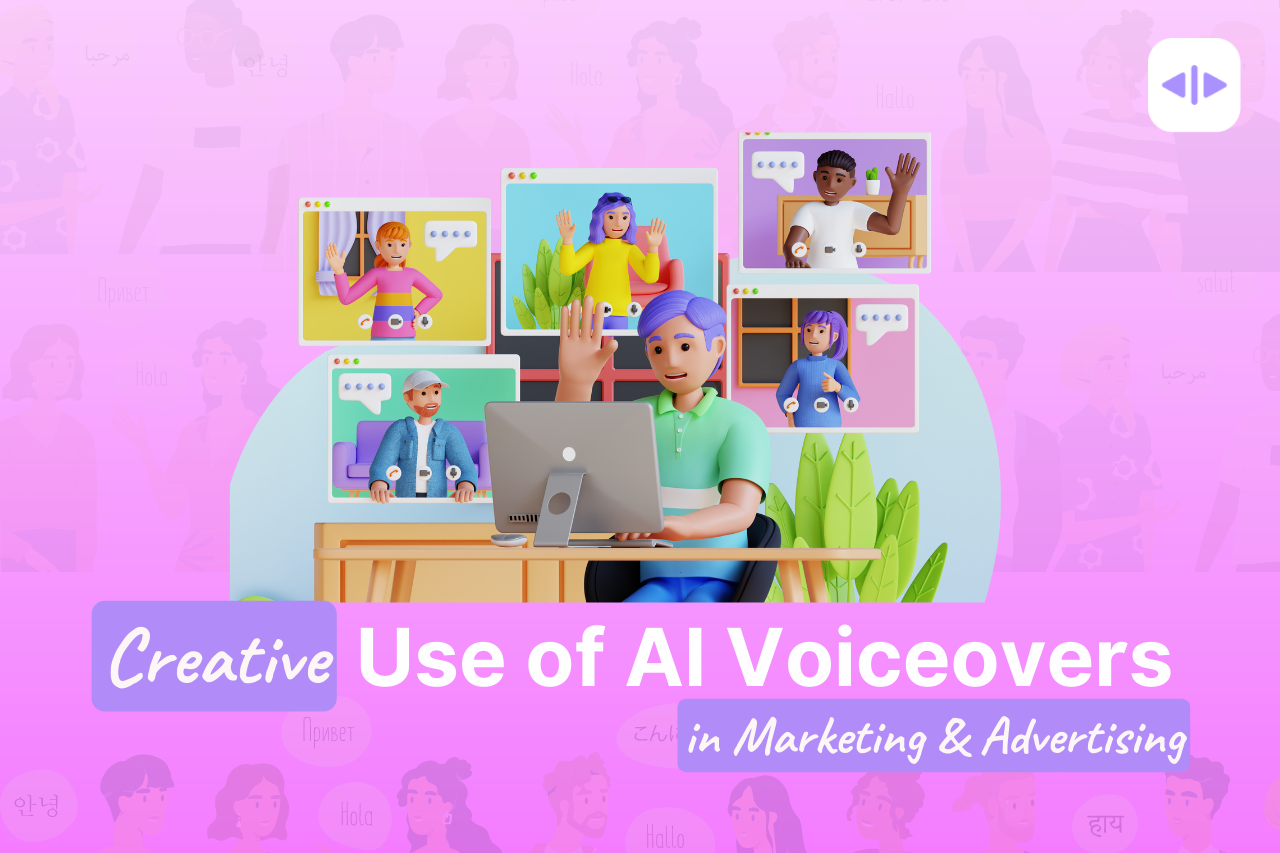In the deep and vast world of content marketing and advertising, the rise of AI voice generators has been nothing short of a revolution. Imagine, instead of expending resources on multiple voice actors for a global ad campaign, you use a single AI tool to produce multilingual voiceovers. Sounds too good to be true? We are here to tell you, it is not. AI voice generators, including Text-to-Speech (TTS) technology and AI dubbing, are rewriting the rules of the game in the content marketing sector. They inject a human-like element into campaigns, allowing for a personalized and engaging experience. Plus, they open up endless possibilities for creativity.
According to Adweek, digital audio advertising spend is set to hit $5.59 billion by 2023, with much of that growth powered by AI voice technology! So, what exactly is this technology, and how can you use it effectively?
What is an AI Voice Generator?
AI voice generators or AI TTS (Text-to-Speech) is an innovative technology that synthesizes human speech. It uses deep learning models to convert text into spoken voice, resulting in a much more natural-sounding speech than traditional text-to-speech systems.
These tools automate audio production and save a lot of time and money. And with multilingual marketing, businesses can easily translate written content and reach broader audiences without hiring a team of language experts, writers, voiceover artists and studios.
The history of AI voice generation goes back decades. Early attempts were limited by technology. But with exponential advancements, progress has been made. Now, AI voice generators make your brand’s message so immersive, even non-humans feel included!
10 Creative Uses of AI Voice Generators in Content Marketing and Advertising
Enhance User Engagement and Experience
- Personalized Ads: AI-generated voices can respond to user queries and provide tailored recommendations. This makes ads more interactive, keeping users engaged.
- Dynamic Podcasting: AI voice generators create lifelike voices, which can be customized to match the genre or tone of the podcast. This makes it more enjoyable for listeners.
- Personality in Virtual Assistants: AI-generated voices make virtual assistants sound more human, increasing user experience. They become more relatable and easier to interact with.
- Storytelling with Feelings: AI voice generators can generate voices with different emotions. Brands can use this technology to create emotionally charged content that resonates with their audience.
AI voice technology is continuously evolving with an aim to deliver even more captivating experiences in the future!
Increase Brand Awareness and Recognition
AI voice generator can help you build a consistent voice for your brand throughout without having to worry about switching artists. AI voices will stay forever without taking any breaks. Brands can clone their own voices or create custom voices to convey their message in a more engaging and memorable way, boosting brand recall.
These tools also enable brands to enhance their user experience through interactive virtual assistants and chatbots. They provide personalized responses and guidance, creating a more seamless customer journey. AI voice technology has also been used for unique purposes such as virtual event hosts or remote presentations.
Using NeoDub speakers can further assist you in having a consistent voice in all languages which was not possible before. A voiceover artist can speak only a few languages, which means brands have to collaborate with different artists to expand across different regions. With NeoDub speakers; however, they can use the same voice for all languages, building a stronger brand identity than ever before!
Listen to Sunidhi speak multiple languages
Listen to Shaan speak multiple languages
Create Podcasts and Audiobooks
The popularity of audio content, such as podcasts and audiobooks, has skyrocketed in recent years. With advancements in technology, AI voice generators have emerged as game-changers in the industry. These innovative tools breathe life into characters, offer emotive narration, and provide a unique listening experience for audiences worldwide.
AI voice generators simplify the creation process and make content accessible to a wide range of individuals. These tools eliminate the need for recording voices or hiring voice actors, making it possible for anyone to generate high-quality voiceovers within minutes. Whether you are an aspiring content creator, an author, or someone with budget constraints, AI voice generators provide a cost-effective solution to anyone and everyone.
With a few clicks, users can synthesize speech in any language. This technology empowers individuals who may not have the resources or desire to record their own voices, enabling them to bring their ideas to life in the form of captivating audio content.
Enhance Social Media Presence
Having a strong social media presence for businesses and brands is not optional. AI voice generators are a powerful tool to boost their presence with minimal resources.
For instance, news organizations often face the challenge of having reporters available 24/7 to deliver breaking news. However, with AI voices, they can overcome this hurdle. By cloning the voices of their human reporters, news channels can generate short news segments at any time, from any location, ensuring an active and timely social presence. This not only enables news outlets to provide up-to-the-minute updates but also allows them to engage with their audience consistently.
The technology also adds personalization to social media interactions. Brands can use customized voiceovers or interactive chatbots powered by AI to provide unique experiences for followers. This helps build stronger connections and enhances loyalty. AI voice generators also offer accessibility options for differently-abled individuals. By providing audio versions of written content, brands can make their social media platforms more inclusive.
Virtual influencers, generated through AI, like Kyraonig, have gained popularity on platforms like Instagram and YouTube. Brands can collaborate with them to reach a wider audience and boost their online presence.
Improve Accessibility and Inclusivity
Businesses can use AI text-to-speech to make content more inclusive. This helps people with disabilities access info. Plus, it’s a great way to show commitment to inclusivity. Marketers can play around with different voices and tones. A friendly tone works great with younger audiences. But an authoritative voice appeals more to professionals.
Streamline and Automate Content Creation
This digital age is fast-paced and content creation is key for marketing and advertising. AI voice generators have come to the rescue, streamlining and automating the content creation process.
Firstly, they save time and effort with no need for manual recordings or editing. Marketers just input the text and get high-quality audio files in seconds. This quickens the process and lets marketers focus on other campaign aspects.
Also, these tools offer personalization and creativity. You can play around with accents, tones, and styles to fit their brand’s identity or target audience preferences. Whether it’s for a fun kids’ product or a calming relaxation app, AI voice generators satisfy diverse needs.
Language Localization
Language localization is the process of customizing products and services based on region or culture. To succeed in the global marketplace, businesses must use the language of their customers.
Native speakers can deliver your message accurately, but they may not be affordable for everyone. This is where AI voice generators solve the problem. AI voice generators make multilingual content production super easy. With AI powering the translation, marketers can convert text to different languages without professional translators or extra resources.
These technologies transform text into natural-sounding human speech in multiple languages. No need to hire expensive voice actors or navigate complex recording studios. AI voice generators offer a range of voices to suit your tone and style.
Boost Conversions and Sales
AI voice generators create realistic, human-like voices that captivate and engage. With AI text-to-speech technology, businesses can personalize their marketing messages and provide an immersive experience for regional and global audiences within a matter of minutes.
AI voice generators can be used to create audio content for websites, social media, and ads. This allows businesses to reach a wider audience and convey their message more effectively. AI technology can also mimic different accents and languages, enabling businesses to target specific markets around the world. Plus, different tones can be generated, from energetic to calm.
Boost Marketing with Voice Generators!
Several leading brands have experienced success in using AI voice generators for their marketing and advertising. From Amazon’s Alexa ads to Mastercard’s AI voice-based customer service, these tools have proven their worth.
The role of AI voice generators in content marketing and advertising is expanding at an unprecedented rate. By creatively harnessing these technologies, creators and enterprises can significantly enhance content engagement, improve user experience, and ultimately drive conversion. It’s time for brands to embrace this exciting technology to stay ahead of their competition.
Frequently Asked Questions
1. What is an AI voice generator?
An AI voice generator is a technology that uses artificial intelligence algorithms to mimic human speech and generate natural-sounding voice recordings. These systems work by analyzing text inputs and transcribing them into audio output, using a range of techniques including machine learning, deep learning, and natural language processing.
2. What are some creative ways to use AI voice generators in content marketing?
Some of the innovative ways that AI voice generators can be used in content marketing include creating audio versions of written content such as blogs and articles, generating spoken product descriptions for online shopping platforms, developing voiceovers for video marketing campaigns, and creating personalized voice messages for customers and clients.
3. Can AI voice generators replace human voice actors in advertising?
While AI voice generators are becoming increasingly advanced, there is still a long way to go before they can fully replace human voice actors in advertising. Human voice actors are able to provide a level of emotional nuance and tonal variation that is difficult for AI systems to replicate. However, AI voice generators can be a useful tool for supplementing human voiceovers and producing high-quality audio content quickly and efficiently.
4. How accurate are AI voice generators at transcribing text into speech?
The accuracy of AI voice generators can vary depending on a range of factors, such as the quality of the initial text input, the sophistication of the algorithms used, and the natural language processing capabilities of the system. However, many AI voice generators are able to achieve a high level of accuracy when transcribing text into speech, particularly when dealing with simple and straightforward sentences. For example, Dubverse’s SAY, an AI-powered text-to-speech tool, is 99% accurate.
5. What are the benefits of using AI voice generators in content marketing?
Using AI voice generators in content marketing can increase efficiency and speed in producing audio content, improve accessibility for visually impaired audiences, offer personalized audio messaging capabilities, and enable the creation of engaging and dynamic marketing campaigns that incorporate different types of media.
6. Are there any ethical concerns around the use of AI voice generators in advertising?
As with any developing technology, there are some ethical concerns around the use of AI voice generators in advertising. Some people have raised concerns about the potential for these systems to be used for fraudulent purposes, such as deepfake voice impersonations. Additionally, there are concerns around the use of AI-generated voiceovers in political advertising and the potential for these systems to be used to spread false or misleading information.



